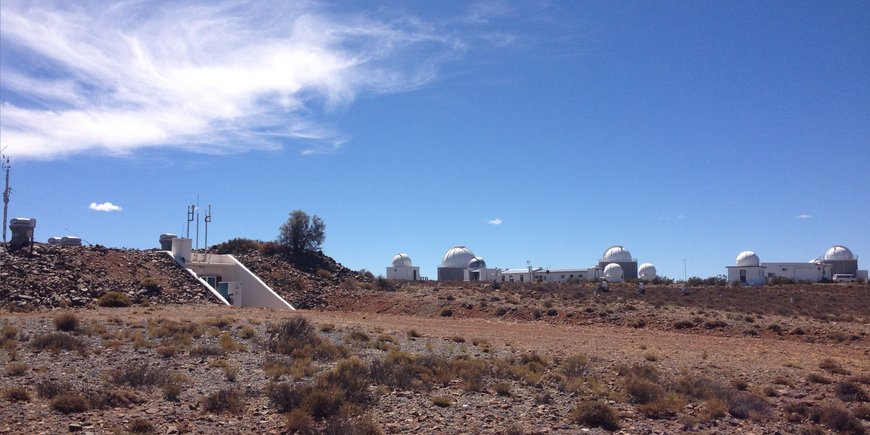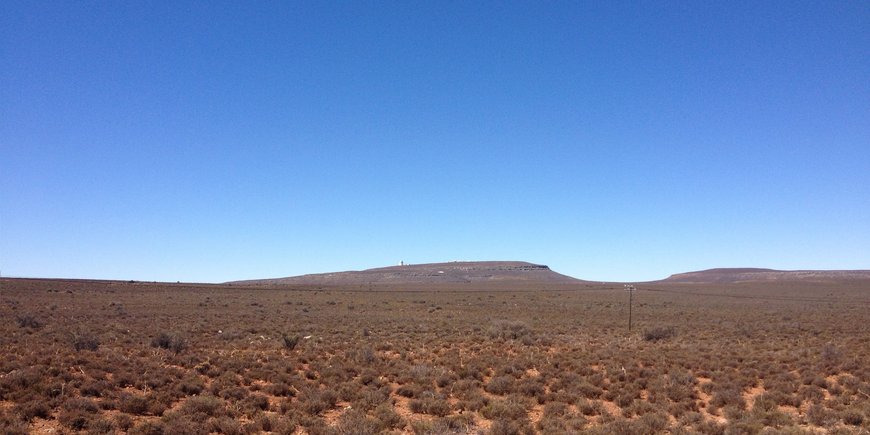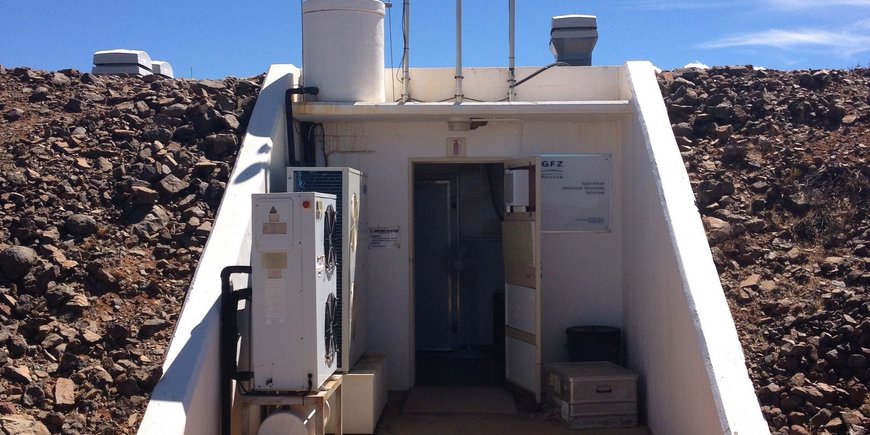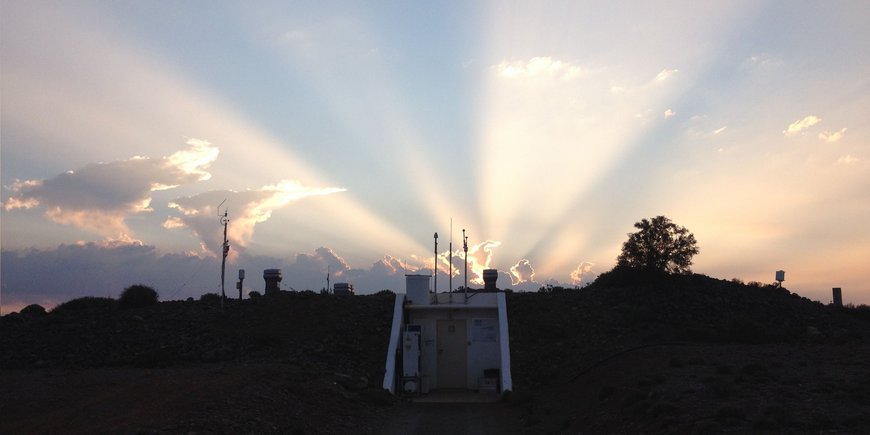The South African Geodynamic Observatory Sutherland (SAGOS) of GFZ was established during the years 1998 – 2000 based on an Agreement on Cooperative Activities between the National Research Foundation (NRF) and GFZ, signed in August 1998. SAGOS is located at the site of the South African Astronomical Observatory (SAAO). The operation and maintenance of the SAGOS instrumentation is jointly done by staff of SAAO and GFZ.
The SAGOS observatory is located about 350 km north-east of Cape Town (longitude: 20.81 E, latitude: 32.38 S, altitude: 1755 m). The shortest distance to the South Atlantic coastline is about 200 kilometres. The area is located in a tectonically quiet zone far away from the African rift. Geologically, the setting is a huge dolerite plateau with a several kilometres thick layer of dolerite. This bedrock allows a good coupling of the Superconducting gravimeter (SG) pillars to the ground. The environment is a remote area with no industry and low seismicity. The climate at this place is determined by the border between summer and winter rainfall zones so that temperature fluctuations are not too rough. The observatory is also built into the ground to protect it against environmental effects like strong winds and temperature changes. All rooms are thermally insulated. An air condition system controls the temperature inside the measurement chamber, which is equipped with three concrete pillars embedded into the dolerite bedrock. Two of the pillars are constructed for Superconducting gravimeters or other geophysical instruments. The third pillar is dedicated for absolute gravimeters for the calibration of the Superconducting gravimeters. In the vicinity of the observatory four further pillars were set up for various other geodetic antennas and instrumentation.
SAGOS is a high precision geodynamic observatory comprising space techniques and ground instruments. Presently the observatory is equipped with
- One Superconducting Gravimeter (OSG D037), which is integrated in the IAG service International Geodynamics and Earth Tide Service IGETS. A second superconducting gravimeter (OSG 052) has been recording data between 2008 and 2017, before it was deinstalled in September 2017 for the operation at Zugspitze (ZUGOG). The data from these SGs are available for registered users from the IGETS data base hosted by GFZ. When using this dataset please cite it as follows
Förste, C., Voigt, C., Abe, M., Kroner, C., Neumeyer, J., Pflug, H., Fourie, P. (2016) Superconducting Gravimeter Data from Sutherland – Level 1. GFZ Data Services. http://doi.org/10.5880/igets.su.l1.001
SGs allow a stationary, continuous high-resolution monitoring of temporal changes of the Earth's gravity field. Main objectives are studying mass transport in the earth's system related to atmosphere, hydrosphere and analysing global geodynamic gravity processes such as polar motion, core modes, Earth & ocean tides and non-tidal loading effects.
- A local network of hydrological sensors (soil moisture, groundwater level, meteorology) in cooperation with Section 5.4 which are essentially needed for the interpretation of the SG measurements
- One permanent GNSS station (station ID: sutm) as a core station of the International GNSS Service (IGS). The data of this station are worldwide used within the geodetic science community for the determination of global and regional reference systems, for the investigation of crustal dynamics, for satellite orbit determination and others.
- One Triaxial Magnetometer, mainly used for investigations of the magnetic oscillation. Additionally, it is used as ground truth for satellite observations. The magnetometer has been installed in co-operation with the Hermanus Geomagnetic Observatory which permanently uses its data for instance in the international PLASMON project (coordinated by the Eötvös Loránd University, Hungary)
SAGOS related publications
2022
Sulzbach, R., Wziontek, H., Hart-Davis, M., Dobslaw, H., Scherneck, H.-G., Van Camp, M., Dahl Omang, O. C., Antokoletz, E. D., Voigt, C., Dettmering, D., Thomas, M. (2022): Modeling gravimetric signatures of third-degree ocean tides and their detection in superconducting gravimeter records. Journal of Geodesy, 96, 35, https://doi.org/10.1007/s00190-022-01609-w
2020
Boy, J.-P., Barriot, J.-P., Förste, C., Voigt, C., Wziontek, H. (2020) Achievements of the First 4 Years of the International Geodynamics and Earth Tide Service (IGETS) 2015–2019, International Association of Geodesy Symposia. Springer, Berlin, Heidelberg, doi: 10.1007/1345_2020_94
Hu, W., Lawson, M. M., Budker, D., Figueroa, N. L., Kimball, D. F. J., Mills, A. P., Voigt, C. (2020): A network of superconducting gravimeters as a detector of matter with feeble nongravitational coupling. - European Physical Journal D, 74, 115, https://doi.org/10.1140/epjd/e2020-10069-8
Rosat, S., Boy, J.-P., Bogusz, J., Klos, A. (2020) Inter-Comparison of Ground Gravity and Vertical Height Measurements at Collocated IGETS Stations, International Association of Geodesy Symposia. Springer, Berlin, Heidelberg, doi: 10.1007/1345_2020_117
2019
Mikolaj, M., Reich, M. and Güntner, A. (2019) Resolving Geophysical Signals by Terrestrial Gravimetry: A Time Domain Assessment of the Correction‐Induced Uncertainty. JGR: Solid Earth 124, doi: 10.1029/2018JB016682
Mulargia, F. (2019) Unexplained spectral peaks in Earth tremor. Geophys. J. Int. 216, doi: 10.1093/gji/ggy420
2018
Bogusz, J., Rosat, S., Klos, A. and Lenczuk, A. (2018) On the noise characteristics of time series recorded with nearby located GPS receivers and superconducting gravity meters. Acta Geod. Geophys.,
doi: 10.1007/s40328-018-0212-5
Cui, X., Sun, H., Xu, J., Zhou, J. and Chen, X. (2018) Detection of free core nutation resonance variation in Earth tide from global superconducting gravimeter observations. Earth, Planets and Space 70:199, doi: 10.1186/s40623-018-0971-9
Shao C.-G., Chen, Y.-F., Sun, R., Cao, L.-S., Zhou, M.-K., Hu, Z.-K., Yu, C. and Müller, H. (2018) Limits on Lorentz violation in gravity from worldwide superconducting gravimeters. Physical Review D 97 (2), doi: 10.1103/PhysRevD.97.024019
2017
Rosat, S., Lambert, S.B., Gattano, C. and Calvo, M. (2017) Earth’s core and inner-core resonances from analysis of VLBI nutation and superconducting gravimeter data. Geophys. J. Int. 208, 211-220, doi: 10.1093/gji/ggw378
Valencio, A., Grebogi, C. and Baptista M. S. (2017) Methods for removal of unwanted signals from gravity time-series: Comparison using linear techniques complemented with analysis of system dynamics. Chaos 27, 103126, doi: 10.1063/1.4996452
2016
Jiang, Y., Xu, J.-Q., Sun, H.-P., Liu, Z.-W. and Li, H. (2016) Theoretical calculation and experimental detection of the inner core translational triplet based on a rotating, slightly elliptical Earth model. Chinese Journal of Geophysics 59 (8), 2754-2764, doi: 10.6038/cjg20160803
Mahed, G. (2016) Gravimetry and Its Application To Geohydrology. South African Journal of Geomatics 5, 301-312, doi:10.4314/sajg.v5i3.3
Mahed, G. (2016) Development of a conceptual geohydrological model for a fractured rock aquifer in the Karoo, near Sutherland, South Africa. South African Journal of Geology 119, 33-38, doi:10.2113/gssajg.119.1.33
Mikolaj, M., Meurers, B. and Güntner, A. (2016) Modelling of global mass effects in hydrology, atmosphere and oceans on surface gravity. Comput. Geosci. 93, 12-20, doi: 10.1016/j.cageo.2016.04.014
Vey, S., Güntner, A., Wickert, J., Blume, T. and Ramatschi, M. (2016) Long-term soil moisture dynamics derived from GNSS interferometric reflectometry: a case study for Sutherland, South Africa. GPS Solut. 20 (4), 641-654. doi: 10.1007/s10291-015-0474-0
Zabranova, E. and Matyska, C. (2016) Low-Frequency Centroid Moment Tensor Inversion of the 2015 Illapel Earthquake from Superconducting-Gravimeter Data. Pure Appl. Geophys. 173, 1021-1027, doi: 10.1007/s00024-016-1252-9







